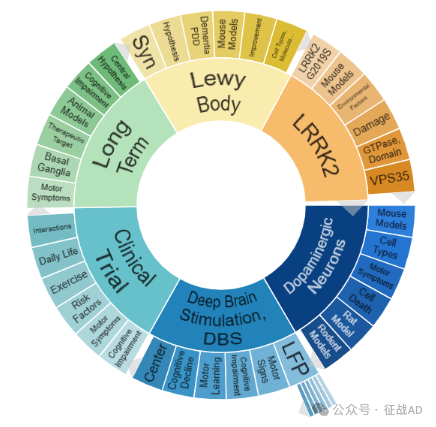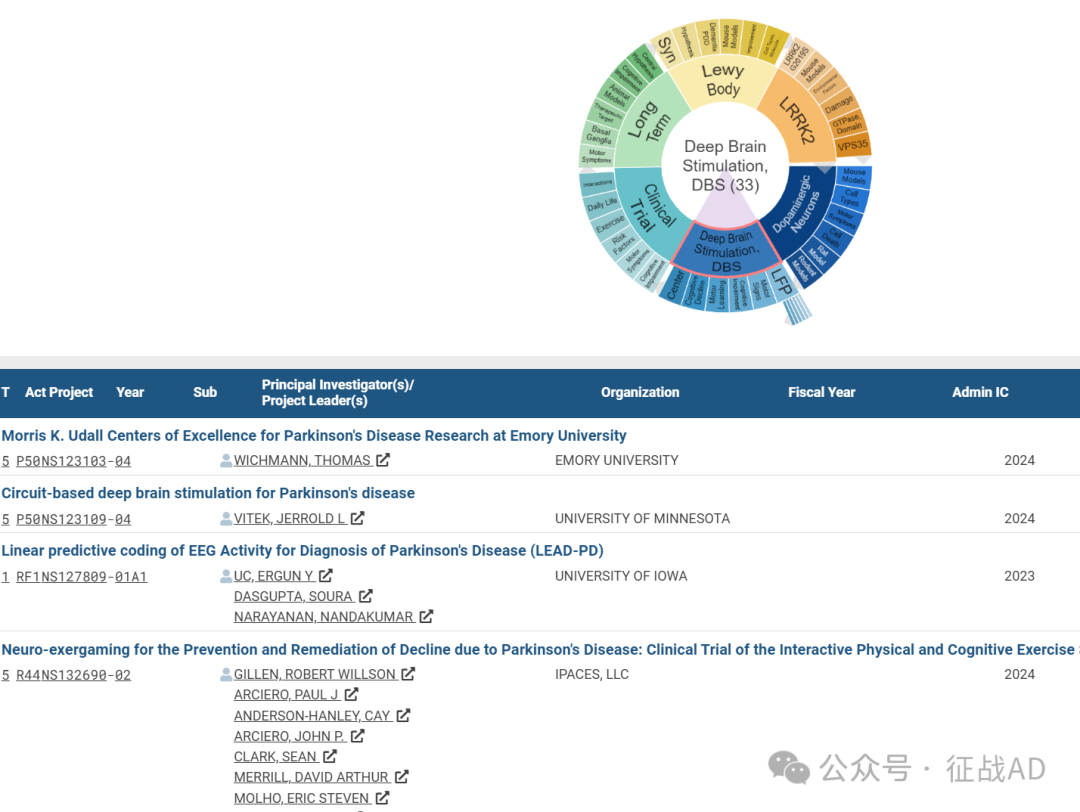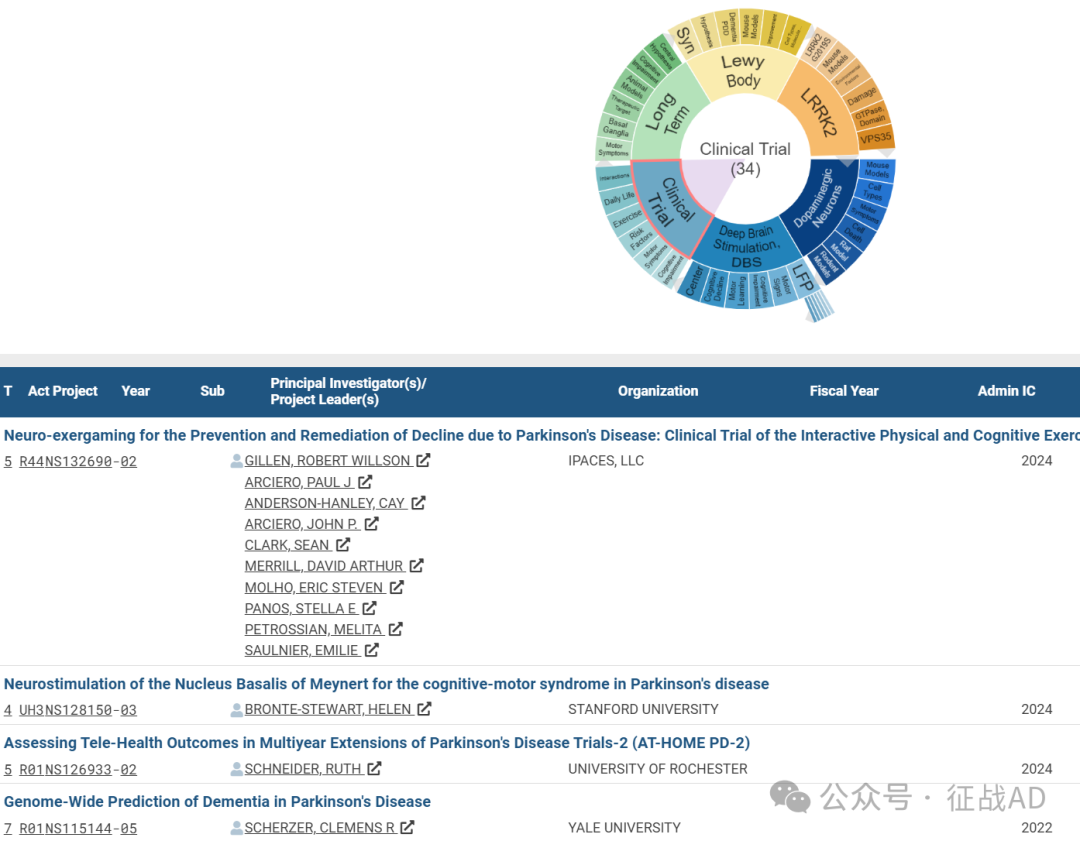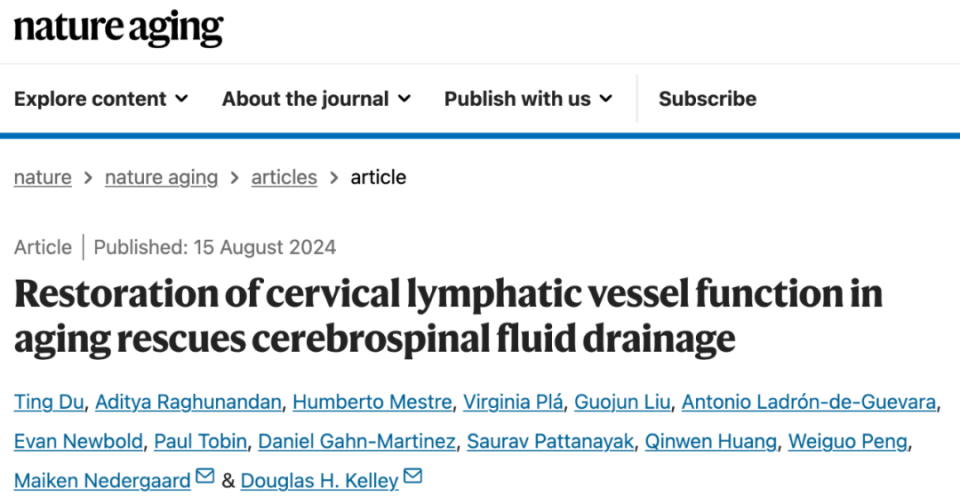帕金森病屡获新突破,美国仍有192项在研基金支持(2024)
13小时前 Hanson临床科研 Hanson临床科研
我们仅对美国国立卫生研究院(NIH)资助的在研帕金森相关项目进行梳理,希望给同仁们的选题思路提供一点启发。
帕金森(Parkinson's Disease,简称PD)是一种逐渐进展的神经系统退行性疾病,主要影响运动功能。它最初由詹姆斯·帕金森于1817年描述,至今仍是中老年人中常见的神经退行性疾病之一。
最近几年,PD的临床诊疗和新药研发领域取得了一系列重要突破。
一、临床诊断的进展
-
生物标志物的发现:
-
α-突触核蛋白检测:研究人员开发了检测脑脊液和血液中错误折叠的 α-突触核蛋白的技术,如 RT-QuIC(实时荧光定量反应),提高了早期诊断的准确性。
-
神经炎症标志物:研究发现某些炎症因子在 PD 患者中水平升高,为疾病的诊断和进展监测提供了新途径。
-
影像学技术的改进:
-
PET 和 MRI:高分辨率的正电子发射断层扫描(PET)和磁共振成像(MRI)能够检测多巴胺能神经元的功能和结构变化,有助于早期诊断。
-
分子影像:使用特异性放射性配体,能够可视化 α-突触核蛋白和其他病理蛋白的沉积。
-
数字技术的应用:
-
可穿戴设备:智能手表和运动传感器可持续监测患者的运动症状,辅助医生进行远程评估和个性化治疗。
-
人工智能和机器学习:通过分析大量患者数据,AI 技术可帮助识别疾病模式,预测疾病进展。
二、治疗方法的创新
-
药物治疗的进展:
-
沙芬酰胺(Safinamide):一种可逆性单胺氧化酶 B(MAO-B)抑制剂,已在多国获批,可改善运动症状并减少运动波动。
-
奥比卡朋(Opicapone):一种长效儿茶酚-O-甲基转移酶(COMT)抑制剂,能延长左旋多巴的作用时间。
-
新型药物:
-
症状改善药物:研发新的多巴胺受体激动剂和抗胆碱能药物,旨在提高疗效和减少副作用。
-
基因疗法:
-
AAV 载体递送:利用腺相关病毒(AAV)载体,将神经营养因子(如 GDNF、NTN)或酶(如芳香族氨基酸脱羧酶,AADC)基因递送至大脑,改善神经元功能。
-
基因编辑技术:CRISPR-Cas9 等基因编辑工具正在研究中,目标是修复导致 PD 的基因突变。
-
细胞疗法:
-
干细胞移植:利用多能干细胞(如诱导性多能干细胞,iPSC)分化成多巴胺能神经元,然后移植到患者大脑中,替代受损的神经元。
-
间充质干细胞:研究其分泌的外泌体和生长因子在神经保护中的作用。
-
免疫疗法:
-
单克隆抗体:针对 α-突触核蛋白的抗体(如 Prasinezumab)在临床试验中,旨在清除有害蛋白聚集,减缓疾病进展。
-
疫苗开发:研究针对病理性蛋白的疫苗,以激发免疫系统清除这些蛋白。
-
神经调控技术:
-
深部脑刺激(DBS):技术改进包括可调节电极和闭环系统,提高疗效并减少副作用。
-
经颅磁刺激(TMS)和经颅直流电刺激(tDCS):作为非侵入性疗法,正在研究其改善运动和非运动症状的潜力。
三、新药研发的突破
-
疾病修饰疗法:
-
LRRK2 抑制剂:针对 LRRK2 基因突变的抑制剂(如 DNL201、DNL151)正在临床试验中,有望减缓疾病进展。
-
α-突触核蛋白聚集抑制剂:小分子化合物(如 Anle138b)旨在阻止有害蛋白的聚集。
-
代谢通路的调节:
-
GLP-1 受体激动剂:如艾塞那肽(Exenatide),用于治疗糖尿病的药物,显示出神经保护作用,正在进行 PD 的临床试验。
-
乌比奎酮(辅酶 Q10)和其他抗氧化剂:研究其在减轻氧化应激、保护线粒体功能方面的作用。
-
核酸疗法:
-
反义寡核苷酸(ASO):针对突变基因的 ASO 可降低有害蛋白的表达,如针对 SNCA 基因的 ASO。
-
小干扰 RNA(siRNA):用于沉默致病基因的表达,正在前期研究中。
四、对疾病机制的新认识
-
肠道-脑轴研究:
-
微生物群的影响:发现肠道菌群失调可能与 PD 的发生和进展有关,探索益生菌和饮食干预作为新的治疗策略。
-
肠道 α-突触核蛋白的传播:研究表明,病理性蛋白可能从肠道向中枢神经系统传播。
-
线粒体功能和能量代谢:
-
线粒体损伤:深入研究线粒体功能障碍在神经元死亡中的作用,开发保护线粒体的疗法。
-
能量代谢调节:研究代谢调节剂在神经保护中的潜力。
小结:
帕金森病的研究正朝着多学科融合的方向发展,从分子机制到临床应用都有显著的进展。虽然目前尚未找到完全治愈的方法,但这些突破为早期诊断、症状改善和疾病进程的减缓带来了新的希望。
尽管如此,PD研究仍存在一些重要而未解决的临床问题:
-
早期诊断:帕金森病的早期诊断仍然具有挑战性,因为早期症状往往不明显且容易与其他疾病混淆。目前缺乏一种简单、准确的测试方法来在早期确诊PD。
-
疾病进展的预测:PD的发展速度在不同患者之间存在显著差异。科学家们尚未能够准确预测疾病的进展路径,这对于治疗策略的制定和患者预后的评估构成挑战。
-
根治疗法的缺乏:虽然目前的治疗方法(如药物治疗和深脑刺激等)可以有效缓解症状,但都不能阻止疾病的进展或逆转神经损伤。研究者正在探索能够治愈或长期控制PD的新疗法。
-
非运动症状的管理:PD患者常伴有非运动症状,如抑郁、焦虑、睡眠障碍和认知下降。这些症状的管理仍然是一个复杂的问题,需要更有效的治疗策略。
PD的研究在不断进展,科学家们正在尝试从基因、分子机制以及新的治疗方法等多方面探索以更好地理解和治疗这一复杂疾病。未来的治疗策略可能会包括早期干预、个性化医疗以及组合疗法,以提高生活质量并延缓疾病进程。
我们仅对美国国立卫生研究院(NIH)资助的在研帕金森相关项目进行梳理,希望给同仁们的选题思路提供一点启发。
2024年,以“Parkinson's Disease”为检索词、在题目中进行检索,美国NIH针对帕金森的在研有192项。
一,谁获得了这些研究?
1,在研帕金森基金最多的PI
-
NATIONAL INSTITUTE ON AGING 的 CAI, HUAIBIN
-
CALIFORNIA PACIFIC MED CTR RES INSTITUTE 的 CUMMINGS, STEVEN RON
-
BRIGHAM AND WOMEN'S HOSPITAL 的 SELKOE, DENNIS J
-
UNIVERSITY OF MINNESOTA 的 VITEK, JERROLD L
-
BETH ISRAEL DEACONESS MEDICAL CENTER 的 SIMON, DAVID K.

2,帕金森基金最多的研究机构
-
明尼苏达大学
-
约翰霍普金斯大学
-
美国国家老龄研究所
-
布莱根妇女医院
-
埃默里大学等

二,帕金森研究热点是什么?
帕金森研究领域总览(根据关键词)

A,关于多巴胺能神经元(Dopaminergic Neurons)的研究项目最多
有 39 项在研基金涉及到了多巴胺能神经元,关注最多的方面包括小鼠模型(Mouse Models)、细胞类型、运动症状(Motor Symptoms)、细胞死亡(Cell Death)、大鼠模型(Rat Model)、啮齿动物模型(Rodent Models)等研究。

B,关于深部脑刺激(Deep Brain Stimulation, DBS)的研究项目
有 33 项在研基金涉及到了深部脑刺激,关注最多的方面包括LFP、运动体征(Motor Signs)、认知障碍(Cognitive Impairment)、运动学习(Motor Learning)、认知衰退(Cognitive Decline)、中心(Center)等研究。

C,关于临床试验(Clinical Trails)的研究项目
有 34 项在研基金涉及到了临床试验,关注最多的方面包括互动(Interactions)、日常生活(Daily Life)、运动(Exercise)、风险因素、运动症状(Motor Symptoms)、认知障碍(Cognitive Impairment)等研究。

其他帕金森研究大的方向还包括长期(Long Term)、路易氏体(Lewy Body)、LRRK2等。
三,借鉴与突破
我们也分享在帕金森领域的几项课题摘要,希望对同仁们有所启发。
A,Biology of Native Alpha-Synuclein Tetramers in Parkinson's Disease
About a dozen labs have subsequently published evidence for the existence of aS tetramers. During this first grant period, we have analyzed the complex T:M equilibrium in health and PD. We found that all fPD missense mutations significantly lower the T:M ratio, including in human neurons. The Ko lab (Hopkins) then discovered that Gaucher’s GBA mutations lower the aS T:M ratio in human neurons. Given this progress, we now wish to extend this entirely novel hypothesis to answer certain key questions relevant to PD, DLB and AD. Our proposed new experiments will be enabled by our having just generated a unique mouse model in which E46K-like, tetramer-abrogating aS mutations cause biochemical, neuropathological and motor phenotypes strikingly resembling PD.
We will address 3 distinct Aims. 1. Deeply phenotype the age- and gender-related temporal development of the PD-like biochemical, neuropathological and motor syndromes of our 3K vs. 1K vs. hu WT tg mice. We will pay special attention to the emerging but unsettled evidence that clusters of membrane vesicles may be the precursors of filamentous Lewy-type bodies that are late-stage lesions. 2. Examine the role of fatty acid saturation and the key cellular desaturase, SCD, as a modulator of the normal aS tetramer:monomer equilibrium in vivo. We will use both genetic and pharmacological lowering of SCD activity to learn if this ameliorates the T:M shift of fPD mutant mice and its many downstream consequences. 3. Ask if our new hypothesis of a possible shared T:M mechanism for aS dyshomeostasis applies to three forms of fPD by a) creating the first mouse with G51D and its amplification as a “3D” mutant; b) extending the discovery of GBA mutations in lowering the T:M ratio; and c) asking if LRRK2 mutations may also alter the aS T:M equilibrium in neurons.
B, Circuit-based deep brain stimulation for Parkinson's disease
The overall goal of the University of Minnesota (UMN) Udall Center is to develop novel, circuit based deep brain stimulation (DBS) therapies for Parkinson’s disease (PD) based on an understanding of the changes in pathophysiological activity patterns that occur in basal ganglia thalamocortical-brainstem (BGTC-B) pathways.
Project 1 (human) will characterize the role of oscillatory activity, coupling and connectivity across the broader BGTC network, including the subthalamic nucleus (STN), globus pallidus internus (GPi), sensory, motor, premotor and dorsolateral prefrontal cortices. These recordings will be performed at rest and during cognitive- motor tasks, with and without therapeutic interventions (DBS, L-dopa, DBS+L-dopa). It will also clarify the relative effect of stimulation in different functional subregions of the STN and GPi on motor and cognitive function.
Project 2 (human) will explore the mechanisms and effects of pallidal DBS on levodopa resistant motor signs using MRI-derived computational models and fMRI to examine the pathways mediating these changes. It will use new sensing technology (Percept) to identify and correlate the physiological changes in the GP to worsening of, or improvement in, gait dysfunction.
Project 3 (non-human primate) will examine the electrophysiological changes in pallido↔peduncular, pallido→intralaminar, and pallido→habenular activity that are related to cognitive-motor symptoms providing further network-level insights into cognitive motor gait impairments, task shifting difficulties, and loss of motivation, which will complement the results from the human studies in Projects 1 and 2.
All center components have synergistic interactions with the Catalyst Project, which will support research efforts of a promising Early Stage Investigator who will use a novel closed-loop DBS approach to probe circuit dynamics in PD patients and their relationship to PD motor signs. The Imaging Core will acquire state- of-the-art, high-field structural MRI as well as rest and task-based fMRI for PD patients in Projects 1 and 2 (using 7T scanner) and structural MRI for the NHPs in Project 3 (using the first of its kind 10.5T scanner).The Clinical Core will obtain clinical and quantitative motor and neuropsychological assessments that will be correlated to physiological data obtained acutely in the operating room, subacutely in patients with externalized DBS leads and electrocorticography arrays, and chronically through postoperative recordings using Percept. The Biostatistics Core will provide overall data management, quality control, statistical and machine learning analysis and data entry into the NINDS Data Management Resource. The Administrative Core will orchestrate all aspects of the UMN Udall Center, implement and support patient education and public outreach efforts, and develop and monitor individualized career enhancement plans for the next generation of PD researchers.
作者:Hanson临床科研
版权声明:
本网站所有注明“来源:梅斯医学”或“来源:MedSci原创”的文字、图片和音视频资料,版权均属于梅斯医学所有。非经授权,任何媒体、网站或个人不得转载,授权转载时须注明“来源:梅斯医学”。其它来源的文章系转载文章,本网所有转载文章系出于传递更多信息之目的,转载内容不代表本站立场。不希望被转载的媒体或个人可与我们联系,我们将立即进行删除处理。
在此留言











前往app查看评论内容
2 0